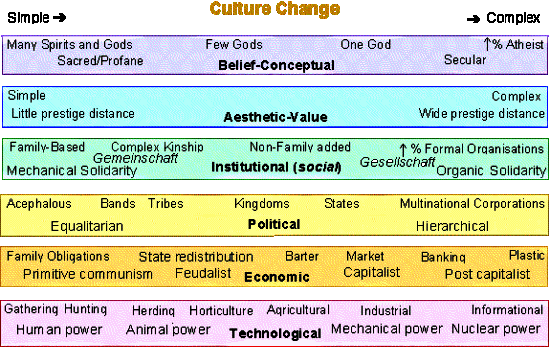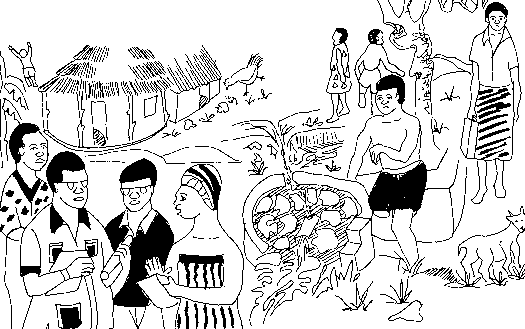Tweet
Translations:
'العربية / Al-ʿarabīyah
Català
中文 / Zhōngwén
Deutsch
English
Español
Filipino/Tagalog
Français
Ελληνικά / Elliniká
हिन्दी / Hindī
Italiano
Polszczyzna
Português
Română
Српски / Srpski
Other formats:
Other Pages:
Modules
Site Map
Key Words
Contact
Utility Documents
Useful Links
Social Research
Contents:
Contents:
Contents:
Contents:
Contents:
COMMUNITY RESEARCH
The Social Organization of the Community
by Phil Bartle, PhD
Module Introduction
What Indicators are Needed for Empowering Communities?
Introduction:
As a mobilizer working in a community, you need to know how the community is set up. What is its social organization? What social structures, patterns and processes make up the community?
You are not merely conducting research to find out about its social organization for the sake of knowledge. You need to know what elements of the community itself will affect how you generate a strategy for empowerment, and will affect how successful you will be.
The best way for you to organize the information you observe (see Social Research Methods, which complements this document), is first to categorize it into the six social-cultural dimensions (see Dimensions). You met them when you were first introduced to the concept of culture and community: Technological, Economic, Political, Institutional, Values and Worldview.
On top of those six categories, add two non sociological categories: Geographic and Demographic.
This paper will review those eight categories of information, with a few suggestions about what you should seek in each. This is incomplete; you may find more information that will be useful.
You need to order your observations, therefore, into the following eight categories:
- Geographic
- Demographic
- Technological
- Economic
- Political
- Institutional
- Ideological and
- Conceptual
The Geography of the Community:
Where is the community located? Is the terrain hilly, mountainous or flat? Is it next to an ocean, a lake, a river? Is the climate cold, hot, mixed, wet, dry, misty? How does the weather change over the year?
What crops, herds, gathering, hunting, and/or agriculture are suitable in the climate and terrain? Are there well defined planting, harvesting, hunting, fishing seasons in the year?
What is the size by area of the community? What shape is made by its boundaries? How is it influenced by its geography? What is its location: latitude, longitude, proximity to other geographic features?
What is the community relationship with the environment ─ ecology? What natural resources are in or nearby: forests, fish, minerals, soil, wildlife, water, oil, or animals? Is the community taking advantage of any of those resources?
Where does the community fit in (location) with its district, region, province and nation?
How do each of these geographic variables affect the community, and its ability to help itself to become more self reliant?
The Demography of the Community:
What is the population size of the community? What is its age structure? What is its dependency ratio (number of young and old in comparison to those of working and productive ages)? Is the age pyramid flat or tall? What is its reproduction rate? What is the ratio between males and females at each age range? How fast or slow is the population changing? Is it increasing or decreasing? Has that rate changed recently?
What is the rate and amount of emigration (moving out), of immigration (moving in) and net migration? What age and sex differences are there in migrations? What proportion of the residents are "outsiders," ie people who have moved in from elsewhere and see themselves still as members of other communities? How many persons have moved elsewhere (including to the major urban areas, outside the country or elsewhere) but consider themselves still members of the community?
Is overall the community population size increasing or decreasing? How fast? What age and sex categories? Why?
How do each of these demographic variables affect the community, and its ability to help itself to become more self reliant?
 |
The Technological Dimension:
What is the broad, general technology? This ranges from simple to complex, early to later. Technologies can include: gathering, hunting, fishing, herding, horticulture, mixed farming, animal powered farming, industrial (machine), post industrial (information). Every community does not necessarily go through all these as stages; some stages may be missed, and most are accumulative (new ones added but old ones do not immediately disappear).
What is the nature of the interface between the culture and its physical environment?
What capital is in the community? This can include communal: roads, electricity, clinics, water supply, schools, sanitation. It can be private: shelter, animal transport, mechanical transport, communication. How is food processed? How is it stored? How are natural resources processed? What tools are used in the community? List them by how they are powered: hand (human), animal, machine (steam, petroleum, electric). Are products produced for sale and export out of the community? If so, how are they transported?
How easy or difficult is it to introduce new technology? How fast is technology changing? What communications technology is available in the community? How may residents write and read? Are there telephones, cell phones, faxes, internet, radio, television, and combinations? What proportion of the community population has access to each?
Describe the overall technology of the community. How do each of these technological variables affect the community, and its ability to help itself to become more self reliant?
The Economic Dimension:
What kinds of social mechanisms are used to allocate wealth? These can include: kin obligations, gifts, potlatch, communal redistribution, barter, monetary trade, plastic and electronic trade. What kinds of wealth can be allocated by one mechanism (eg marriage partners) but not by others (eg through money).
What is the degree of monetization? Are farm and fish products sold or used for immediate consumption, or both? What ratio?
How much cash might be available for communal fund raising? What sources are available for fund-raising and how much for each? These can include wealthy patrons, migrants in the cities willing to send money home for development, local factories and commercial firms willing to contribute, cash crop farmers and fishers.
Where does the community fit on a rural-urban spectrum?
Is credit available? Are there savings rotation clubs, loan sharks, pawn shops, banks, credit unions, trust organizations, stock brokerage? What proportion of the community population has access to each? Describe the overall economic system of the community.
How do each of these economic variables affect the community, and its ability to help itself to become more self reliant?
The Political Dimension:
What are the mechanisms through which power and influence are allocated in the community? These can include: traditional (by succession, chieftaincy, family power), modern democratic (voting, representational democracy), power broking (unions, associations, organizations), charisma.
How much influence do persons have without being recognized formally as political leaders? These include religious leaders, educational leaders, senior civil servants, senior health practitioners, elders in influential kin groups, wealthy individuals. What influence is exercised without political power? How extant is the traditional (eg pre-colonial) political system?
What external factors are important? These can include national party politics, influential absent community members, and others that you might observe.
Describe the overall political system of the community. How do each of these political or power variables affect the community, and its ability to help itself to become more self reliant?
The Social / Institutional Dimension:
What patterns of interaction are part of the social fabric of the community? What is the family and kinship system? Is there a chieftaincy system? Is it traditional or co-opted by the national governmental system, or bits of both?
What organizations are part of the community (non profit, commercial, governmental)? What clubs, congregations, political parties, ethnic and other associations are part of the community social organization?
What is the rate, extent and nature of civic engagement? Are factions in competition with each other? What is the potential for unity organizing to reduce conflict between factions? How much and in what ways have modern, non family organizations replaced the functions formerly taken care of solely by the kin system? How much social interaction is moulded by various kinds of social institutions? What is the potential for forming and developing community based organizations for self help projects?
Describe the overall social and interaction system of the community. How do each of these sociological variables affect the community, and its ability to help itself to become more self reliant?
The Ideological / Values Dimension:
What are the values shared in the community (right, wrong, beautiful, ugly, good, bad)? Are there values that differ from faction to faction?
What political values are shared? What are the major differences in political values? What religious values are shared? How much does organized religion define community values? What values will affect how self help groups can be organized?
Describe the overall ideological or value system of the community. How do each of these value variables affect the community, and its ability to help itself to become more self reliant?
The Conceptual / Worldview Dimension:
How do members of the community see the universe? How do they explain causes of disease and misfortune? What are their beliefs? To what degree are they shared versus part of disagreements? What universal or global religions are represented in the community? How much are traditional religious beliefs shared by community members?
What is the amount of syncretism (adding new beliefs without subtracting contradictory old ones) in the community? What proportions of the community see themselves as members of formal religious organizations?
Describe the overall conceptual / worldview system of the community. How do each of these conceptual or worldview variables affect the community, and its ability to help itself to become more self reliant?
Conclusion:
It is necessary for you, the mobilizer, or manager of a district mobilization programme, to understand the social organization of a community that you aim to empower. While the social organization is interesting in itself, and part of our general sociological and anthropological body of knowledge, your purpose is more practical.
For all these social elements, which vary from community to community (so we call them social variables), you need to estimate their effects on the community and what strategy of mobilization may be most effective, and how successful it may be.
Observations about these social indicators are essential to managing a community empowerment programme that goes beyond a single mobilizer in a single community, so complete records should be kept, and the information stored (and easily retrieved) in a Management Information System (MIS).
––»«––
What is the Community Social Organization?
 |